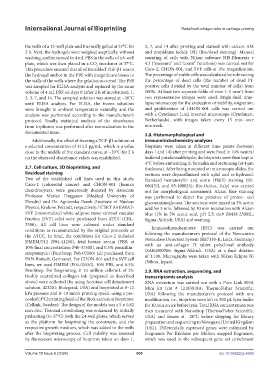Page 508 - IJB-10-6
P. 508
International Journal of Bioprinting Redefined collagen inks in cartilage printing
the wells of a 12-well plate and thermally gelled at 37°C for 3, 7, and 14 after printing and stained with calcein AM
2 h. Next, the hydrogels were weighed aseptically, without and propidium iodide (PI) (live/dead staining). Manual
washing, and immersed in 4 mL PBS in the wells of a 6-well counting of cells with Nikon software NIS-Elements v
plate, which was then placed in a CO incubator at 37°C. 4.3 (“measure” and “count” functions) was carried out for
2
This procedure ensured that all of the added TGF-β1 was in Caco-2, CHON-001, and SVF cells at 10× magnification.
the hydrogel and/or in the PBS with insignificant losses to The percentage of viable cells was calculated by subtracting
the walls of the wells where the gelation occurred. The PBS the percentage of dead cells (the number of dead PI-
was sampled for ELISA analysis and replaced by the same positive cells divided by the total number of cells) from
2
volume of 4 mL PBS on days 0 (after 2 h of incubation), 1, 100%. At least two separate fields of view (~1 mm ) from
2, 3, 7, and 14. The sampled solution was stored at −20°C two representative images were used. Bright-field time-
until ELISA analysis. For ELISA, the frozen solutions lapse microscopy for the evaluation of viability, migration,
were brought to ambient temperature naturally, and the and proliferation of CHON-001 cells was carried out
analysis was performed according to the manufacturer’s with a CytoSmart Lux2 inverted microscope (CytoSmart,
protocol. Finally, statistical analysis of the absorbance Netherlands), with images taken every 15 min over
from triplicates was performed after normalization to the one week.
documented mass.
2.8. Histomorphological and
Additionally, the effect of freezing a TGF-β1 solution at immunohistochemistry analyses
a selected concentration of 312.5 pg/mL, which is a value Bioprints were taken at different time points (between
close to the middle of the standard curve, at −20°C for 2 h days 1 and 14) after printing and were fixed in 10% neutral
on the observed absorbance values was established. buffered paraformaldehyde; the bioprints were then kept at
4°C before embedding in formalin and sectioning (at 4 µm
2.7. Cell culture, 3D bioprinting, and thickness). After being mounted on microscopic slides, the
live/dead staining sections were deparaffinized with xylol and re-hydrated.
Two of the established cell lines used in this study, Standard hematoxylin and eosin (H&E) staining (05-
Caco-2 (colorectal cancer) and CHON-001 (human 06015/L and 05-10002/L; Bio-Optica, Italy) was carried
chondrocytes), were generously donated by Associate out for morphological assessment. Alcian blue staining
Professor Marian Draganov (Medical University of was performed to detect the presence of proteo- and
Plovdiv) and Dr. Agniezska Panek (Institute of Nuclear glycosaminoglycans. The sections were mixed in 3% acetic
Physics, Krakow, Poland), respectively; hTERT A41hWAT- acid for 3 min, followed by 30 min incubation with Alcian
SVF (immortalized white adipose tissue stromal vascular blue (1% in 3% acetic acid, pH 2.5; cat# B8438-250ML;
fraction [SVF] cells) were purchased from ATCC (CRL- Sigma-Aldrich, USA) and washing.
3386). All cell lines were cultured under standard
conditions as recommended by the original protocols or Immunohistochemistry (IHC) was carried out
the ATCC. In brief, the conditions for Caco-2 included following the manufacturer’s protocol of the Novocastra
DMEM/F12 (P04-41250), fetal bovine serum (FBS; at Peroxidase Detection System (RE7110-K; Leica, Germany)
10% final concentration; P40-37500), and 0.5% penicillin- with an anti-collagen II rabbit polyclonal antibody
streptomycin (Pen/Strep; P06-07100) (all purchased from (SAB4500366; Sigma-Aldrich, USA) at a final dilution
PAN-Biotech, Germany). For CHON-001 and the SVF cell of 1:100. Micrographs were taken with Nikon Eclipse Ni
lines, we used DMEM (P04-05550), 10% FBS, and 0.5% (Nikon, Japan).
Pen/Strep. For bioprinting, 8–10 million cells/mL of 2% 2.9. RNA extraction, sequencing, and
freshly neutralized collagen ink (prepared as described transcriptomic analysis
above) were collected (by using Accutase cell detachment RNA extraction was carried out with a Pure Link RNA
solution, 423201; Biolegend, USA) and bioprinted at 8–12 Mini kit (cat # 12183018A; ThermoFisher Scientific,
kPa pressure and 8–10 mm/s printing speed, using a pre- USA) following the manufacturer’s protocol with one
cooled (4°C) printing head of the BioX extrusion bioprinter modification, i.e., bioprints were left in 500 µL lysis buffer
(Cellink, Sweden). The design of the models was a 5 × 0.82 for 10 min on ice before lysis. Total RNA concentration was
mm disc. Thermal crosslinking was enhanced by initially then measured with Nanodrop (ThermoFisher Scientific,
preheating (to 37°C) both the 24-well plates, which served USA) and frozen at −20°C before shipping for library
as the platform for bioprinting the constructs, and the preparation and sequencing to Novogene (United Kingdom
respective growth medium, which was added to the wells [UK]). Differentially expressed genes were estimated by
after the bioprinting process. Cell viability was assessed Fragments Per Kilobase per Million mapped fragments,
by fluorescent microscopy of bioprints taken on days 1, which was used in the subsequent gene set enrichment
Volume 10 Issue 6 (2024) 500 doi: 10.36922/ijb.4566

